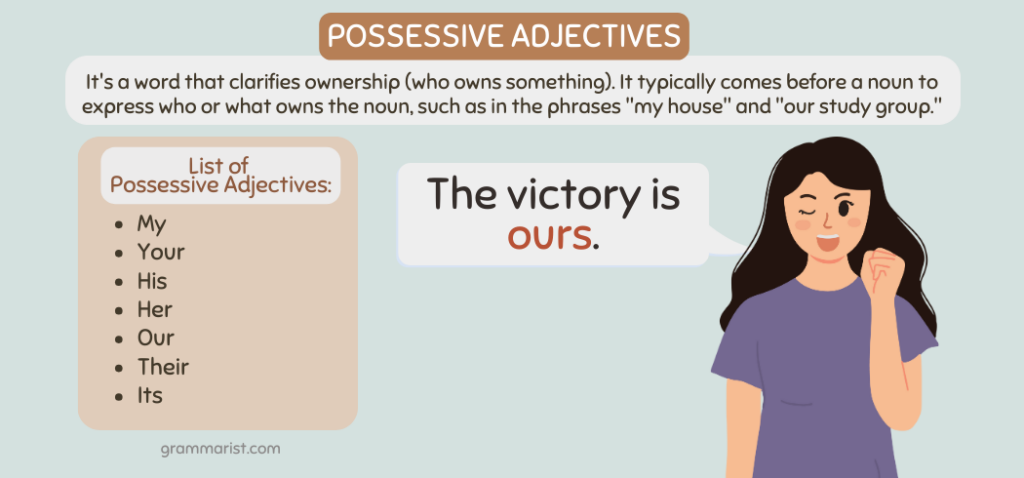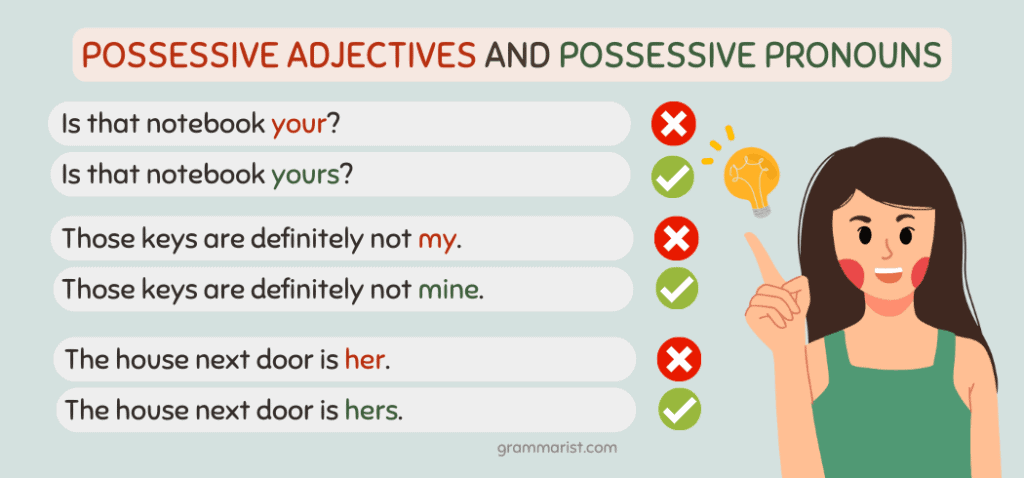Are you interested in improving your English grammar? Are all articles and their content confusing? Possessive adjectives are a common part of speech, so it’s important to learn how to use them correctly.
What Is a Possessive Adjective?

In terms of possessive adjective definition, it’s a word that clarifies ownership (who owns something). They can only be used before the noun they refer to.
It typically comes before a noun to express who or what owns the noun, such as in the phrases “my house” and “our study group.”
It’s a type of adjective that can also be used more generally to express general possession, such as in the phrases “his car” and “their books.” Examples of common possessive adjectives include my, your, his, her, our, their, and its.
Because possessive adjectives are so frequently used in everyday communication, writers and speakers need to understand their grammatical functions and correct usage.
What Are the 7 Possessive Adjectives?
Here’s my list of possessive adjectives:
- My
- Your
- His
- Her
- Our
- Their
- Its
Mistakes When Using Possessive Adjectives
As a former editor and full-time writer, I see these mistakes more often than I should. Take note.
Don’t Write “It’s” if You Mean “Its” (Or Vice Versa)
This is a very common mistake, even for people who are native English speakers. That single apostrophe that stands between these two words makes a huge difference and tells us something different about each word and when to use it.
“Its” is a possessive adjective, while “it’s” is the shorter version of “it is.”
Don’t Write “You’re” if You Mean “Your” (Or Vice Versa)
Another common mistake is confusing “you’re” and “your” interchangeably. Much like with “its” and “it’s,” one is a possessive adjective while the other is a shorter version of two words.
While they may look and sound similar, there is actually a very important difference between them. Your is a possessive pronoun, meaning it refers to something that belongs to or is related to the person speaking. For example, if I say, “I love your shoes,” I am telling you that I like the shoes that belong to you or that are connected to you in some way.
On the other hand, you’re is simply a contraction of the words “you” and “are.” This means that when someone asks you a question using “you’re,” they are asking if you are something or someone – for example, if they ask, “You’re late again?” they are inquiring whether or not you are late.
So, while they may look and sound similar, it’s important to remember that your and you’re are two distinct concepts in the English language.
Don’t Confuse “There,” “They’re,” and “Their”
There are different ways to refer to something or someone, and three of the most commonly used are “there,” “they’re,” and “their.” At first glance, these words may seem quite similar, but in fact, they have very distinct uses.
“There” is primarily used to indicate a physical or abstract location. For example, you might say, “I’m going over there,” or even, “There’s nothing more I can do.” It can even be used as a way of drawing attention to something, such as in the phrase, “Let me know if you spot anything there.”
In contrast, “they’re” is short for “they are.” As such, it is often used to indicate the present or future tense. For example, you might say things like, “They’re planning on attending the conference” or “They’re going to try their best.”
Meanwhile, “their” is simply a possessive form that can be used about both people and things. So you might say things like, “Here is their report card,” or simply ask questions like, “Whose book is this? Is it theirs?”
In sum, while there may be some overlap between these terms in their use and meaning, they each have distinct purposes that make them useful in different contexts.
Don’t Write “Who’s” if You Mean “Whose” (Or Vice Versa)
“Whose” and “who’s” are two commonly confused words that are typically used in different contexts. “Whose” is a possessive determiner that is used to indicate ownership or family lineage, whereas “who’s” is short for “who is” and is commonly used as a contraction when asking questions about someone or something.
For example, we might say, “Whose car is that over there?” to indicate car ownership, while we would say, “Who’s the new student in our class?” to ask who the new student in our class happens to be.
Don’t Use “His/Her”
In English, talking about people in general warrants the use of a non-gender-specific word.
For example:
- Each dog owner should pick up after his or her dog.
While the above sentence is technically correct, it’s lengthy and uses too many unnecessary words. The more correct way to say it is, “Each dog owner should pick up after their dog.”
Gender-Neutral and Nonbinary Possessive Adjectives
It is possible to use the adjective “their” as a singular gender-neutral or nonbinary equivalent for the gender-specific adjectives “her” and “his, and this usage is becoming more common.
You can use it in situations where you do not wish to or are unable to indicate the gender of a person. One who identifies as nonbinary is another person who can be referred to using this term. In this scenario, it is essential to make use of the adjectives (and pronouns) that the individual in question wants to have used.
It’s essential to avoid incorrectly identifying a person, even unintentionally, by sloppy use of gendered language in contexts where it is not required. There is a simple approach to ensure that your words and writing are welcoming to people of all gender identities by using gender-neutral vocabulary. The word “their” is great if you are unsure which possessive adjective is the most appropriate.
Where Do You Include a Possessive Adjective in a Sentence?
Other types of adjectives can have different places in a sentence. On the other hand, possessive adjectives can only be used before the noun they refer to.
You can say, “This is my book,” but you can’t say, “This book is my.”
Possessive Adjectives and Possessive Pronouns

It’s important to note that possessive adjectives can’t be used as objects, subjects, and subject complements. In these situations, you need possessive pronouns.
Here is a possessive adjectives chart that can help you learn the correct form.
| Pronoun | Possessive Adjective | Possessive Pronoun |
| I | My | Mine |
| You | Your | Yours |
| She | Her | Hers |
| He | His | His |
| It | Its | Its |
| They | Their | Theirs |
| We | Our | Ours |
Let’s take a look at some correct vs. incorrect examples of when and how to use possessive pronouns:
- Incorrect: The victory is our.
- Correct: The victory is ours.
- Incorrect: Is that red car their?
- Correct: Is that red car theirs?
- Incorrect: Those keys are definitely not my.
- Correct: Those keys are definitely not mine.
Possessive Adjectives and Determiners
In English grammar, certain words are known as determiners. These are words placed in front of a noun to clarify what the noun refers to.
There are three types of determiners in English:
- Determiners of quantity: one, two, thirty, many, several, some, any, etc.
- Determiners of specificity: this, that, a, an, the, etc.
- Determiners of ownership: my, mine, yours, hers, their, theirs, etc.
As you can see, determiners of ownership are very similar to possessive adjectives, so what’s up with that?
Ownership determiners cover both possessive adjectives and possessive pronouns.
Possessive Adjective Examples in a Sentence
To further expand your knowledge and help you understand, here are all the possessive adjective examples used in sentences.
- I don’t know why my car won’t start anymore.
- Sarah knows your little secret.
- Mike was very happy with his new laptop.
- My sister went to the doctor because she knows it was for her own good.
- I can’t turn on the TV because I can’t find its remote.
- Parents should know where their children are at all times.
- It’s our fault the kids broke the vase. We shouldn’t have left them unsupervised.
Its vs. It’s
One of the most common mistakes even native English speakers make is improper usage of its and it’s.
- It’s = the short version of “it is”
- Its = possessive adjective
Possessive adjectives are never written with an apostrophe. Let’s look at some examples:
- Correct: It’s about time we talked this through.
- Incorrect: Its about time we talked this through.
- Correct: I loved my old phone for its remarkable battery life.
- Incorrect: I loved my old phone for it’s remarkable battery life.
Final Thoughts on the Difference Between Adjectives That Are Possessive
A possessive adjective is a word that clarifies who owns something and typically comes before a noun. They can also express general possession. The seven possessive adjectives are my, your, his, her, our, their, and its.
It’s important not to confuse “its” with “it’s,” “you’re” with “your,” or “whose” with “who’s.” You can use the adjective “their” as a gender-neutral equivalent for “his” or “hers.”